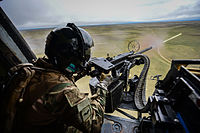Majestic Hermes
This article is incomplete because it is pending further input from participants, or it is a work-in-progress by one author. Please comment on this article's talk page to share your input, comments and questions. Note: To contribute to this article, you may need to seek help from the author(s) of this page. |
| Majestic Hermes | |
|---|---|

| |
| Role | Utility, SAR and ASuW helicopter |
| Designer | Majestic International |
| First flight | 07 April 2008 |
| Introduction | 10 December 2012 |
| Status | In service |
| Primary user | Belfrasian Army Republic Navy See Operators |
| Produced | 2008-present |
The Majestic Hermes was designed for service in the battlefield utility, search and rescue, and anti-surface warfare roles within both the Belfrasian Army and Republic Navy to replace the aging Majestic Falcon. Whilst the Wildcat improves on several major fronts from it's predecessor, requirements caused it to retain the same passenger requirements.
Models of the Hermes in usage by both the Belfrasian Armed Forces and abroad utilize the expertise and experience gained by the Cold War. The aircraft operates a single, common airframe in every variant that yields some stealth qualities whilst also consisting of entirely new-age cockpits and a hugely versatile range of armaments to conduct its duties.
The helicopter was formally introduced in 2012 as the primary helicopter for both the Belfrasian Army and the Republic Navy. The helicopter has also been acquired by the Neidmarrian Army and Navy in similar roles as the Belfrasian Armed Forces.
Design
One of the most notable distinctions of the Hermes is it's similarity in appearance to it's predecessor, the Majestic Falcon. Whilst they are visibly similar, however, the Hermes is comprised of over 95% newer components, sharing only the 2006 refits to the Falcon in it's gearbox and fuel system. The newer components allow for a fully digital cockpit, an improved durability of the newer components and a sleaker, more jagged frame that provides the helicopter with some stealth qualities.
The helicopter was designed to mimic it's predecessor in a multitude of variants focusing around an Army and Republic Naval basis whilst sharing a common airframe. This standardized airframe is equipped with a wheeled undercarriage, is marine-usage certified, and possesses the necessary survival systems for emergencies involving water landings. New crashworthy and armoured crew/passenger seating along with armoured cabin flooring protects the aircraft's crew from ground based fire. Systems are native aboard the aircraft for the protection against wire or ground strikes to the aircrafts rotors and a new-age engine infrared suppression system is also seen on the helicopter to drastically reduce it's detectability in the battlespace. Commonality in engine design and computers allow for an expedition in repairs with universally available parts capable of being relocated with little difficulty. The airframe also comes standard with a electro-optical/infrared turret mounted on the nose for observation and search purposes. The turret is also fitted with a laser designation system to carry out thirty party designation of targets for the guidance of weapons onto targets.
The new, fully digital cockpit of the aircraft includes a universal console, allowing for data to be available anywhere on the helicopter and for displays to be customized as the crew sees fit using liquid crystal displays. Systems exist for the settings or information to be uploaded or downloaded to the helicopter prior to it's mission for expediting the adding of mission specific data that the helicopter will need but is not urgent enough for upload whilst in flight. The standard Belfrasian models of the helicopter utilizes the Belfrasian Standard Secure Communications Control System (BSEC) seen aboard the majority of modernized Belfrasian military helicopters.
Attachment points exist for weapon pylons to be attached on both sides of the aircraft just behind the cabin doors. Points also exist for pintles to be installed at both cabins for crew served machine guns for both offensive and self defence purposes. The weapons pylons that can be attached to the aircraft with one pylon per side. The Republic Navy Hermes HMA.1 mounts an active electronically scanned array (AESA) radar under the nose and is usually seen carrying short-range anti-submarine weapons or anti-ship weapons such as the Scorpion missile. The Scorpion is seen again aboard the Army version, the Hermes AH.1 that also is fitted with guided missile pods and cannon pods as the need allows. Tests proved that the adding of the weapon wings can take as little as four hours, although it was stressed by engineers that a days worth of checks are necessary to ensure no failures happen whilst on mission.
Operational History
Belfras
Belfrasian Army

Variants
- Hermes HMA.1 - Belfrasian Army version for surveillance and utility purposes.
- Hermes AH.1 - Republic Navy version for maritime duties.
Operators
Specifications
General characteristics
- Crew: 2 pilots
- Capacity: 5-8 passengers (including door gunners)
- Length: 15.25 m (50.0 ft) ()
- Rotor diameter: 12.80 m (42.0 ft) ()
- Height: 3.75 m (12.3 ft) ()
- Loaded weight: 6 kg (13 lb) ()
- Powerplant: 2 × Majestic MHE-8200 turboshafts, () each
Performance
- Maximum speed: 190 mph (310 km/h)
- Range: 485 mi (781 km) ()
Armament
- Guns: Pintle mounted machine guns, 20mm autocannon on weapon pylons.
- Hardpoints: 2× attachable weapon pylons on either side of aircraft, 2× pintle mounts inside cabin.
- Missiles:
- Air-to-air missiles:
- Air-to-ground missiles: Scorpion missile, Agkulis missile
- Bombs:
- Others:
- Air-dropped torpedoes
- Sonobouys


